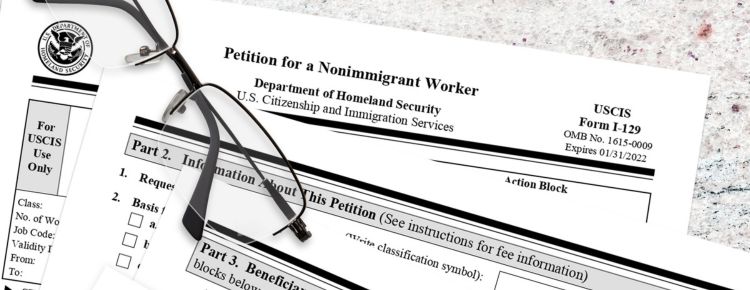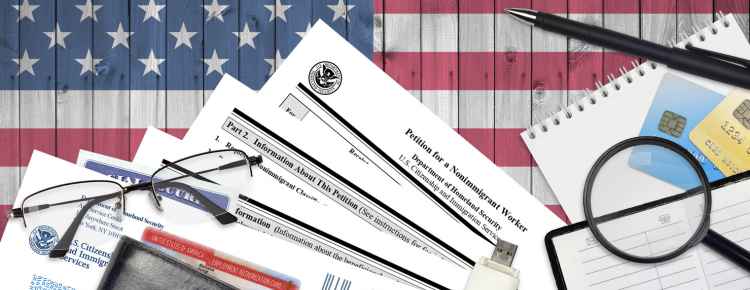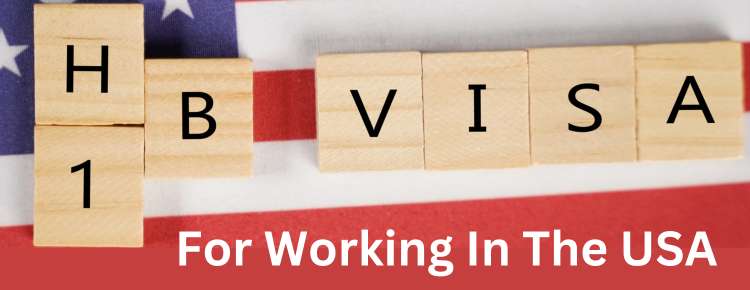Navigating The I-129 Petition Process For Nonimmigrant Workers

If you’re puzzling over Form I-129 for hiring nonimmigrant workers in the U.S., look no further. This article demystifies the filing process, requirements, and fees, equipping employers with the knowledge to proceed confidently. Discover the specifics of completing the form, the essential documents you’ll need, and how to avoid common errors, ensuring your petition stands on solid ground.
Key Takeaways
- Form I-129 is an essential petition filed by U.S. employers to sponsor foreign nationals for temporary work across various nonimmigrant classifications, including but not limited to H-1B, L-1, and O-1 visas.
- Filling out Form I-129 requires meticulous attention to detail, provision of extensive information specific to each nonimmigrant classification, and submission of supporting documents as proof of eligibility.
- Form I-129 is critical not just for initial employment, but also for extension or change of an employee’s nonimmigrant status, requiring adherence to eligibility criteria, correct documentation, and understanding of the processing timeline.
Understanding Form I-129: A Comprehensive Overview

Form I-129 acts as your conduit to inviting foreign expertise to your U.S. enterprise. This form, filed by you, the employer, with the United States Citizenship and Immigration Services (USCIS), is the cornerstone of your nonimmigrant worker’s journey to legally working for your organization. Once approved, your nonimmigrant worker is authorized to commence or continue working at your establishment.
The vital role of Form I-129 is reflected in its goal: sponsoring foreign nationals for temporary work in the U.S.. It serves as a critical component in the visa application process for several nonimmigrant visa classifications. Essentially, Form I-129 is the first step in securing talent from abroad.
What Is Form I-129?
Fundamentally, Form I-129 serves as a petition for a nonimmigrant worker. As a U.S. employer, you use it to bring foreign workers to the United States for temporary employment in various categories. This main form provides a means for you to sponsor foreign nationals for temporary work in the U.S..
From H-1B visas for specialty occupations to L-1 visas for intracompany transferees, Form I-129 is integral to the visa application process for several nonimmigrant visa classifications. So, whether you’re looking to bring in a software engineer from India under the H-1B category or transfer an executive from your Canadian branch under the L-1 classification, Form I-129 is indispensable in your immigration journey.
Who Can Use Form I-129?
Form I-129 doesn’t adopt a one-size-fits-all approach. It’s designed to cater to specific nonimmigrant classifications. There are several classifications of visas, such as:
- H-1B
- H-2A
- H-2B
- H-3
- L-1
- O-1
- O-2
- P-1
- P-1S
- P-2
- P-2S
- P-3
- P-3S
- Q-1
- R-1
These are just a few examples.
Form I-129 is not solely for new employment petitions. It also becomes relevant when a foreign national already in the U.S. aims for an extension of stay or a change of status to E-1, E-2, E-3, H-1B1, or TN. So, whether you’re petitioning for a new worker or looking to extend or change the status of a current foreign national employee, Form I-129 is your go-to tool.
Filling Out Form I-129: Step-by-Step Instructions

Though it might appear overwhelming, navigating Form I-129 is certainly manageable. The key lies in understanding the form’s requirements and meticulously providing accurate and complete information. Wondering how to fill out Form I-129? Here’s a step-by-step breakdown.
From identifying the right nonimmigrant classification to providing all necessary supporting documents, each step of the Form I-129 process is crucial. But filling out the form is just the first step. Moving forward, let’s examine the required information and supporting documents in more detail.
Required Information
Filling out Form I-129 requires a plethora of information tailored to the specific nonimmigrant classification. For example, employers seeking to bring in workers under H-1B, H-1B1 Chile/Singapore, L-1, and O-1A classifications must complete Part 6 of Form I-129, which pertains to the release of controlled technology or technical data to foreign persons in the U.S..
Depending on the nonimmigrant classification, you might need to provide evidence of the proposed job being a specialty occupation or present a Labor Condition Application certified by the Department of Labor. Furthermore, for H-3 nonimmigrants, you’ll need to present supporting evidence, including details of the training program, staff, and facilities. Clearly, the information required is extensive and specific, underlining the need for meticulous attention to detail.
Supporting Documents
Alongside the required information, Form I-129 also necessitates specific supporting documents, known as required initial evidence. These documents serve as proof of the beneficiary’s qualifications, contracts, and even certified translations for documents not in English.
For instance, H visa category petitions require specific documents like DOD project descriptions for Defense Department project workers, and explanations of the training’s necessity and benefits for H-3 trainees. L visa petitions need evidence of physical premises for the new office and financial ability, along with detailed job duties and qualifications. The supporting documents required are as diverse as the visa classifications themselves, further emphasizing the need for meticulous preparation.
Tips For Avoiding Delays and Errors
While the process of completing Form I-129 can seem intricate, following a few tips can help you sidestep delays and mistakes. To ensure a smooth procedure, it is recommended to:
- Complete the entire form accurately
- Use black ink and type or print legibly
- For any non-applicable item, use ‘N/A’
- Avoid errors at all costs as they might necessitate restarting the form
Make sure to submit legible copies, not originals, of supporting documents in English, with certified translations for any documents in foreign languages. Assemble the application package in the USCIS-recommended order, use single-sided, standard letter-size pages, and send the package to the correct USCIS address with a tracking-capable courier.
These tips and more can help streamline your Form I-129 filing process, minimizing delays, and errors.
Form I-129 Filing Process And Timeline

Having filled out Form I-129 and gathered all the necessary information and documents, you might ask, ‘What comes next?’ The filing process commences. As the employer, you must file the petition with USCIS. The form must be submitted to the appropriate USCIS Service Center, depending on the nonimmigrant classification sought and your location.
But when should you file Form I-129? It is advised to file the form at least 45 days before the prospective employment start date and no more than 6 months in advance. However, different requirements may apply for employment in fashion modeling or for Department of Defense cooperative research and development projects.
With the petition filed, let’s explore the filing fees, payment methods, and the filing fee exemption supplement.
When And Where To File Form I-129
The ‘where’ and ‘when’ of filing Form I-129 are critical aspects of the process. For employment or services in the Commonwealth of the Northern Mariana Islands (CNMI), regardless of classification, the form must be filed with the Texas Service Center.
Certain nonimmigrant classifications, including:
- E-1
- E-2
- E-3
- H-3
- R-1
- Q-1
- P-1
- P-2
- P-3
- O-1
- O-2
must also file Form I-129 at the Texas Service Center.
Employers should avoid submitting a Form I-129 petition more than 6 months before the employment start date, as per advice. This timing is recommended to ensure compliance with regulations. To extend any authorized period of stay, employers should file at least 45 days before the expiration of the current authorized stay. It’s all about timing, ensuring that the form is filed neither too early nor too late.
Filing Fees And Payment Methods
Filing Form I-129 is accompanied by specific fees, including biometric services fees when applicable. As of the latest information available before April 1, 2024, the required fee for processing Form I-129 is $460. Remember, the filing fee is non-refundable, regardless of whether the petition is withdrawn or denied.
Payments can be made using a money order, personal check, cashier’s check, or by credit card with Form G-1450. Note that additional fees for specific visa petitions may apply, which can vary depending on the visa category, company size, and the proportion of employees in certain nonimmigrant statuses. Always ensure that payments are made accurately to avoid any hiccups in the process.
Processing Time And Status Updates
Once Form I-129 is filed and the fees paid, the waiting game begins. The processing time for Form I-129 can vary based on the USCIS Service Center processing the form and the nonimmigrant visa category. USCIS offers a case processing time tool that predicts timeframes for processing Form I-129 based on the form category and the responsible USCIS office.
As the petitioner, you can check the status of the Form I-129 online using the USCIS case status tool with the 13-character receipt number. Current Form I-129 processing times are available on the USCIS website for different visa categories and Service Centers. For status updates via phone, petitioners inside the U.S. can contact the USCIS National Customer Service Center, while those outside the U.S. have specific numbers and international field offices to contact. It’s always essential to stay informed about the status of the petition.
Extending Or Changing Nonimmigrant Status With Form I-129

Form I-129 is not solely purposed for bringing foreign workers to the U.S.; it also serves as a crucial tool for extending or changing nonimmigrant status. In other words, if you’re an employer with a foreign national already working for you in the U.S., Form I-129 is your key to prolonging their stay or altering their nonimmigrant classification.
What happens when the nonimmigrant worker’s current nonimmigrant work visa is nearing expiration, or if a change in their employment status necessitates a change in their nonimmigrant classification? Form I-129 comes into play. Employers must file Form I-129 to apply for an extension or change of nonimmigrant status for their workers who are in specific nonimmigrant visa categories. This process is crucial for maintaining the legal status of nonimmigrant workers in the U.S..
Eligibility Criteria
To extend or change a nonimmigrant worker’s status using Form I-129, certain eligibility criteria must be met. For instance, nonimmigrant workers in classifications like E-1, E-2, E-3, H-1B, H-1B1, L-1, O-1, or TN have a grace period of up to 60 days following employment termination to maintain legal status. This grace period allows temporary non agricultural workers to file for a change of status, seek new employer-sponsored nonimmigrant status, or transition to a dependent, student, or visitor temporary visa.
However, to be eligible to request an extension or change of nonimmigrant status using Form I-129, the individual must meet the following criteria:
- They must have been lawfully admitted into the U.S. with an appropriate nonimmigrant visa.
- They must not have committed acts that would render them ineligible for immigration benefits.
- There must be no other factors mandating their departure from the U.S.
These criteria ensure that only those maintaining legal status are eligible for extension or change of status.
Required Documentation and Procedure
Requesting an extension or change of nonimmigrant status using Form I-129 involves a specific procedure and required documentation. The petitioner must file a request for an extension of stay on behalf of the beneficiary using Form I-129 before the expiration date on Form I-94 or as noted in the passport or travel document.
The beneficiary must also apply for an extension of stay, another immigration benefit, or must depart the United States before the expiration date on Form I-94. Similarly, dependent family members must use Form I-539 to request an extension of stay, apply for another immigration benefit, or depart the United States before their own Form I-94 expires. The procedure and required documentation for immigration benefit requests are designed to ensure the seamless extension or change of status for nonimmigrant workers.
Navigating The Visa Approval Process

Having successfully negotiated the Form I-129 filing process for an existing visa, you’re now ready to tackle the visa approval process. After the USCIS approves Form I-129, a notice is sent to the National Visa Center, which will instruct you, the petitioner, on the next steps for visa application. The beneficiary must then complete the DS-160, Online Nonimmigrant Visa Application, as part of the requirements for obtaining a nonimmigrant visa.
The next crucial step is the visa interview. The beneficiary is required to schedule and attend a visa interview at a U.S. consulate or embassy in their home country to move forward with the visa process. The visa approval process, although intricate, is a crucial phase in securing a nonimmigrant visa for your foreign worker.
Form I-797, Notice Of Action/Approval
After Form I-129 is approved, USCIS sends an I-797, Notice of Action, to notify you, the petitioner, of the approval. This form serves as an official notification of action taken on the petition, and its receipt marks a significant milestone in the visa application process.
Upon approval of Form I-129, the beneficiary must present Form I-797, Notice of Action, or a copy of the approved Form I-129S while attempting entry or re-entry into the United States under the approved employment category. Attorneys representing the petitioner may also receive a courtesy copy of the I-797 approval notice.
Form I-797B is specifically issued for the approval of a noncitizen worker petition, such as those filed with Form I-129.
Consular Processing And Visa Issuance
The last stage in the visa application process involves consular processing and visa issuance. Even after Form I-129 is approved by USCIS, visa issuance isn’t guaranteed as the visa status still needs to be determined. The consular officer will review the petition and screen the beneficiary during the visa interview.
To assist the beneficiary with the visa interview process, a consular packet with documents and instructions can be provided. This step, though nerve-wracking, is the final phase before the visa is issued and the nonimmigrant worker can legally begin or continue their employment in the U.S.
Summary
Navigating the Form I-129 process, from understanding the form to navigating the visa approval process, can be a complex journey. Yet, with a clear understanding of the steps involved, from filling out the form to the visa issuance, it is undoubtedly manageable. Remember, each step, whether it’s providing the correct information, submitting the right supporting documents, or adhering to the filing process and timeline, plays a significant role in successfully securing a nonimmigrant visa for your foreign worker. As an employer, it’s your key to unlock the world of global talent and bring it to your U.S. enterprise.
Frequently Asked Questions
What is I-129 used for?
Form I-129 is used by an employer to petition for a beneficiary to come temporarily to the United States as a nonimmigrant to perform services or labor, or to receive training. It is filed with U.S. Citizenship and Immigration Services (USCIS).
What does I-129F approval mean?
The approval of Form I-129F by USCIS means that your application for a fiancé visa has been reviewed and accepted, indicating that the intended marriage is recognized. You will now need to follow any additional instructions provided by USCIS to proceed with obtaining the visa.
Is I-129 same as H-1B?
Form I-129 is the petition filed with USCIS by a prospective H-1B employer seeking approval to employ an H-1B worker. It is used for many non-immigrant petitions, including H-1B, O-1, TN, and E-3 extensions and change of status petitions.
Who can use Form I-129?
Form I-129 can be used by U.S. employers to petition for nonimmigrant workers in various employment classifications such as H-1B, H-2A, L-1, O-1, and more.
How can I avoid errors when filling out Form I-129?
To avoid errors when filling out Form I-129, make sure to complete the entire form accurately, use black ink, type or print legibly, and use “N/A” for non-applicable items. Additionally, submit legible copies of supporting documents in English, with certified translations for any foreign language documents.
Related Blog

Check USCIS Case Status Online | Quick Guide
Are you seeking to check your USCIS case status without the hassle of phone calls and in-person appointments? The USCIS online portal provides a seamless and convenient way to access your immigration case status. This blog post will guide you through the process of effortlessly checking your USCIS case status online, helping you stay informed […]

Navigating The I 539 Form For Nonimmigrant Status Changes
If you’re a nonimmigrant in the U.S. needing to extend or change your status, navigating the I-539 form is a critical step. This guide simplifies the application process, highlighting what you need to know to file successfully without risking your legal stay. Learn the essentials without the guesswork. Key Takeaways Understanding Form I-539: Purpose And […]

H1B Visa Eligibility, Requirements and Application
H1B visa is an employer-sponsored nonimmigrant work visa allowing U.S. employers to hire foreign workers (who are not citizens or permanent residents of the U.S.) for a specific period of time (up to 6 years) having specialty occupations to work in the U.S. The employee must have a bachelor’s degree or equivalent (with the exception […]


